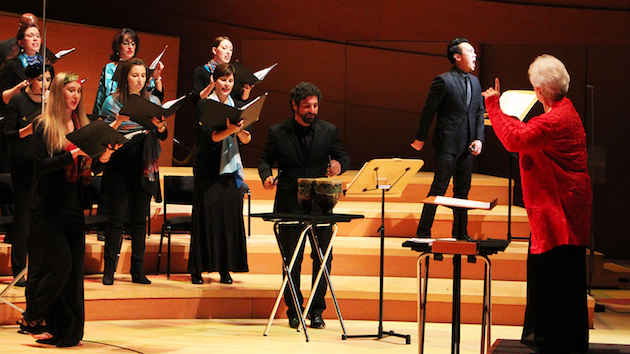
There were two contrasting, and seemingly unrelated stories in Monday’s edition of the Los Angeles Times. The first recounted a “tide of refuges” fleeing Venezuela in order to escape that country’s “hyperinflation, food shortages, lack of work, and lawlessness.” A few pages later a very different story detailed the megabucks bonanza that big chain stores like Target and Wal-Mart are cashing in on selling every type of costume and paraphernalia related to the Mexican/Central American celebration known as Día de los Muertos (The Day of the Dead).
The event that threads them together (that did not appear) was Sunday night’s Día de los Muertos concert, performed by the Los Angeles Master Chorale, curated and conducted by the artistic director of Schola Cantorum of Venezuela, María Guinand.
For three decades Guinand has been a guiding force for the instruction of choral music in Venezuela and its child-music program, El Sistema. She is also a close friend and associate of Gustavo Dudamel, whose Los Angeles Philharmonic just conclude a series of concerts devoted to the music of Mexico City.

During a preconcert conversation Guinand admitted that with conditions the way they are in her native country she found it challenging to put together a program devoted to the Day of the Dead. She also pointed out that the Day of the Dead is a major celebration in Mexico and Central American, not Venezuela, and that it represents a fusion of pre-Columbian Aztec culture with Spanish Catholicism.
The work, Guinand said, that provided her with a theme for her program was La Muerte Sonriente (The Smiling Death), a 2013 composition by the rising young Mexican composer, Diana Syrse, whose composition, Connected Identities, was a high point of the Los Angeles Philharmonic’s recent Green Umbrella concert.
With administrative support from the Getty Museum, the entire Los Angeles region (as far away as Palm Springs) is immersed in a vast cultural event called Pacific Standard Time: LA/LA, designed to celebrate the influence of Latin American culture in all aspects of the arts. Día de los Muertos was the Los Angeles Master Chorale’s contribution.
The program, as conceived by Guinand, divided the concert into two emotionally contrasting halves — Part 1: Death; Part 2: Celebration. And while there were a number of members of the audience that arrived in a party mood, made up as skeletal calaveras in Mexican finery, the concert really didn’t go in that direction.
When Guinand took the microphone and dedicated the evening to the “souls of those that have died fighting for democracy” in Venezuela, the die was cast. The first work, Lamentaciones de Profeta Jeremías was written in 1946 by Alberto Ginastera at a time when the Argentine composer was living in exile in the U.S. for his political activity in opposition to the military dictatorship of Juan Peron. The lamentations, which are a study in suffering as the acts of a wrathful Old Testament God allows his “chosen people” to be sent into exile.

Diversity of origin and musical identity was a key component of the program, which featured choral works by composers from Argentina, Brazil, Mexico, Cuba, and America. Another clear statement was made when Guinand led the Chorale in an evocative performance of Réquiem Osun (1986) by the Cuban composer, Calixto Álvarez. The work offers bold vocal contrasts as it interpolates European classicism (and the Latin text of the Requiem mass) with rich Afro-Cuban rhythms and traditional Yoruban chants sung in the creolized Lucumi dialect. The nasality of this dialect and the resulting harmonies infused the work with an atmospheric sense of its African roots, emphasized by the solo voice of soprano Holly Sedillos.
The first half also included literary references to death. Rodolfo Halffter’s Tres Epitafios (Three Epitaphs) evoked the impossible dream of Don Quixote, the idealized tavern wench, Dulcinea, and the ever-loyal sidekick, Sancho Panza.
From the realm of the bull ring and death in the afternoon, the 2016 composition, Concierto para Coro by the Venuzuelan composer, Miguel Astor is set to the poem, Muerto de Antoñito El Camborio by Federico Garcia Lorca. But rather than dying nobly, the young matador is murdered after being arrested by the Guardia Civil. As was Lorca.
The second half of the concert was meant to be a “Celebration,” but even though the female members accentuated their first-half funereal black with brightly colored scarves, the concert never did achieve an air of festivity.

It began with a piece by the evening’s one non-Latin composer, Ola Gjeilo from Norway. His 2001 liturgically-based composition, Unicornis Captivatur (The Unicorn is Captured) combines modern harmonies with elements of Gregorian Chant set to a 15th-century text.
The dotted, up-beat melody of Cántico de Celebración by the Cuban composer, Leo Brouwer, was followed by Jubiabá by Carlos Alberto Pinto Fonseca. It represented a joyful expression that pulsed and swayed (as did Guinand and the Chorale) to its incorporation of Afro-Cuban rhythms.
Salve al Celestre Sol Sonoro paid homage to its composer, Alberto Grau, the man who founded Venezuela’s Schola Cantorum, of which Guinand is chief conductor.
The best was saved for last — La Muerte Sonriente by Diana Syrse. Her piece, which also included several traditional wind and percussion instruments, captured the spirited atmosphere of the Day of the Dead as none of the works before it had done. She is a rising star. It allowed the couples dressed as the Calaveras to leave smiling.
CORRECTION: An earlier version of this article identified the soprano soloist in the Requiem as Ayana Haviv. It was actually Holly Sedillos.




